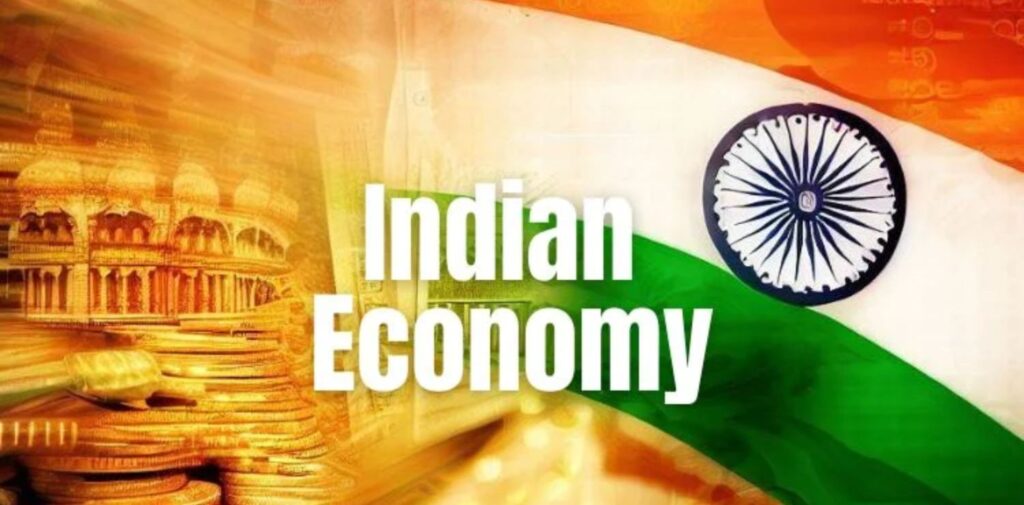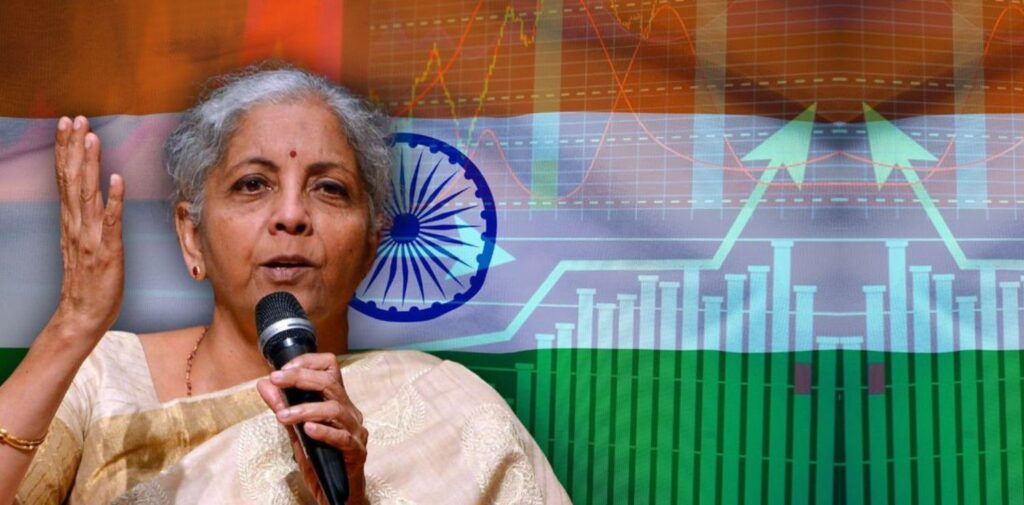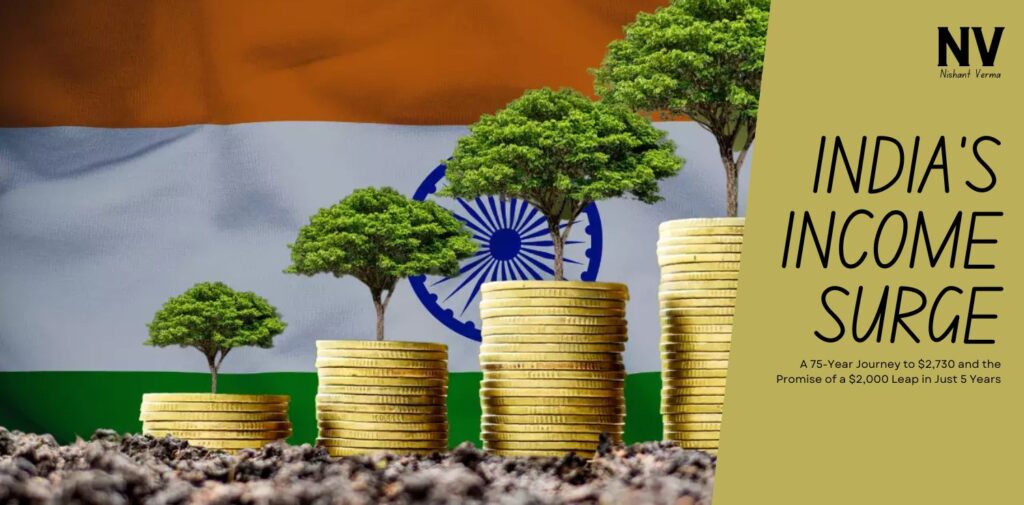India has embarked on an extraordinary economic journey since its independence, reaching a significant milestone with a per capita income of $2,730. But what took 75 years to achieve, Finance Minister Nirmala Sitharaman predicts will take only another five years to add $2,000. This projection is a testament to India’s evolving economic landscape and reflects the accelerated pace of growth and development the country is currently witnessing.
The statement made by FM Sitharaman not only exudes optimism but also reflects a profound transformation in India Income Surge. The journey from a nascent, agrarian-based economy to becoming one of the fastest-growing major economies in the world has been one of challenges, reforms, and resilience. The forecast of adding $2,000 more to the per capita income in just five years is a bold claim that indicates confidence in India’s economic strategies, structural reforms, and policy measures. But what makes this growth possible? Let’s delve deeper into India’s path to prosperity and explore what this leap means for the future of the nation.
India Income Surge: From Independence to $2,730 Per Capita
In 1947, the newly independent India faced immense socio-economic challenges. The country’s economy was predominantly agrarian, with limited industrialization and a per capita income of less than $100. Over the decades, India adopted various five-year plans aimed at achieving self-reliance and economic stability. The Green Revolution, Industrial Policy Reforms, and the establishment of the Public Sector Units (PSUs) laid the foundation for industrial and agricultural growth.

However, the real turning point came with the economic liberalization of 1991. The dismantling of the License Raj reduced import tariffs, and opening up markets to foreign investments unleashed the country’s potential. Since then, India has steadily progressed, making significant strides in sectors like information technology, manufacturing, services, and more recently, startups and innovation.
Today, with a per capita income of $2,730, India is no longer perceived as merely a developing nation but rather as an emerging economic powerhouse. However, this achievement took 75 years of cumulative effort. So, how is it that India now aims to achieve a further $2,000 per capita growth in just five years?
The $2,000 Leap: Why the Next Five Years Will Be Different
India’s ambition to add $2,000 to its per capita income in such a short period is rooted in a multitude of favorable factors and economic dynamics that have begun to converge:
Structural Reforms and Policy Overhauls: Recent years have seen a slew of structural reforms aimed at creating a conducive environment for economic growth. Measures such as the implementation of the Goods and Services Tax (GST), the Insolvency and Bankruptcy Code (IBC), and labor reforms have streamlined processes and made doing business easier.
Foreign Direct Investment (FDI) Inflows: India has become a favored destination for global investors. With robust FDI inflows, especially in sectors like technology, pharmaceuticals, and manufacturing, the country has attracted billions of dollars in investment, driving growth and creating jobs.
Make in India and PLI Schemes: The government’s focus on boosting domestic manufacturing through initiatives like ‘Make in India’ and Production-Linked Incentive (PLI) schemes is fostering a strong industrial base. This not only reduces dependency on imports but also enhances export capabilities, thereby increasing national income.
Expanding Digital and Startup Ecosystem: India’s tech-savvy population has led to the rise of a dynamic startup ecosystem. With over 100 unicorns, India is positioning itself as a global hub for innovation. This growth is not only contributing to GDP but also improving per capita income through high-paying jobs and wealth creation.
Focus on Infrastructure and Connectivity: Massive investments in infrastructure, including roads, railways, ports, and airports, are set to improve connectivity, reduce logistics costs, and stimulate economic activity across regions.
Demographic Dividend: India’s young workforce is one of its biggest assets. With the right skilling and employment opportunities, this demographic dividend can significantly boost productivity and economic growth.

Challenges to Overcome: Why the Path Ahead is Not Without Hurdles
While the forecast of adding $2,000 to per capita income in just five years is promising, it is crucial to acknowledge the challenges that lie ahead:
Income Disparity: Despite the growing economy, income inequality remains a major concern. The benefits of growth need to reach all sections of society, particularly the marginalized and rural populations.
Job Creation: To achieve such rapid income growth, substantial job creation across sectors is essential. The unemployment rate must be addressed, and efforts should be made to create quality jobs that provide sustainable livelihoods.
Inflation and Cost of Living: Rising inflation and a higher cost of living can dilute the impact of income growth. Policymakers must ensure that inflation remains in check, and the purchasing power of citizens is maintained.
Global Economic Conditions: India’s economy is not immune to global disruptions. Factors like geopolitical tensions, fluctuations in oil prices, and a slowdown in global growth can impact India’s growth trajectory.
What This Growth Could Mean for India’s Future
If India manages to achieve this ambitious target, it could have far-reaching implications for the country:
Poverty Alleviation: A significant increase in per capita income could help uplift millions of people out of poverty, improving overall living standards.
Boost to Consumption: As incomes rise, so will consumption, leading to increased demand for goods and services. This could further stimulate economic activity, creating a virtuous cycle of growth.

Greater Investment in Health and Education: Higher incomes could translate into greater investment in critical sectors like health and education, leading to a more skilled and healthier population.
Enhanced Global Standing: A rapidly growing economy will bolster India’s global standing, making it an even more attractive destination for investments, trade, and strategic partnerships.
Conclusion: The Road to 2029 and Beyond
The forecast of adding $2,000 to India’s per capita income in just five years is more than just a statement of intent—it’s a reflection of the potential that the country holds. The convergence of reforms, favorable demographics, and strategic investments could make this leap a reality. However, sustained efforts, inclusive growth, and resilient policies will be key to navigating the challenges ahead.
As India stands on the cusp of this new economic era, achieving this target will not only uplift incomes but also pave the way for a more prosperous and equitable society. The journey that took 75 years to reach $2,730 may soon seem like a foundation stone for what India could achieve in a fraction of the time, heralding a future where the dream of economic prosperity for all becomes a tangible reality.




